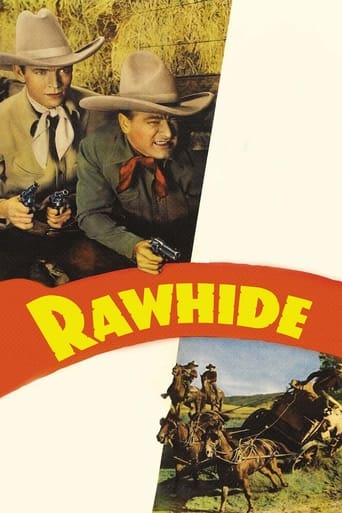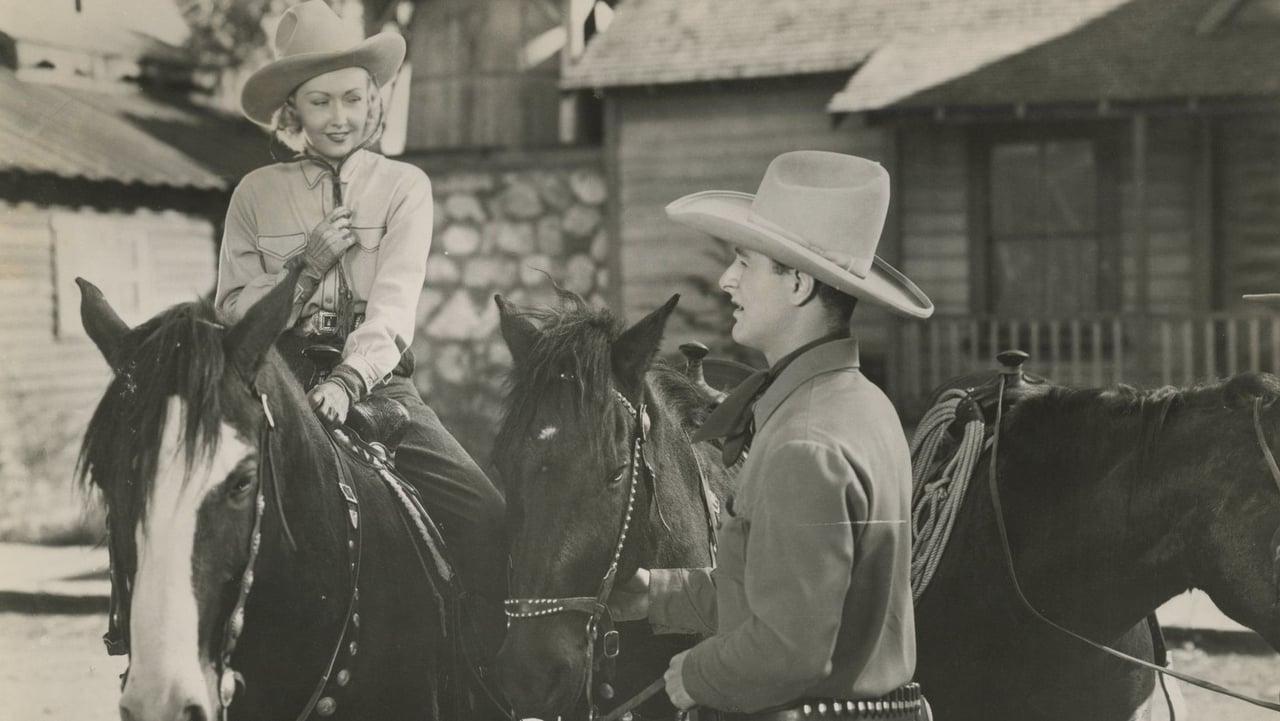JohnHowardReid
Copyright 8 April 1938 by Principal Productions, Inc. New York opening at the Globe: 24 April 1938. Released through 20th Century-Fox: 8 April 1938. Australian release: 16 June 1938. 6 reels. 59 minutes.
SYNOPSIS: Baseball star buys a ranch.COMMENT: In his first and only Hollywood feature, baseball legend Lou Gehrig (later to be immortalized by Gary Cooper in Pride of the Yankees) understudies the now-forgotten Smith Ballew, a popular singer of the time, who made five "B" westerns for Fox (this is the fourth) in the late 1930s. Although Ballew displays a pleasant voice and personality in the main role, all eyes are on Gehrig in support. He handles himself with a professional finesse (all sports people are actors after all), exhibiting enough individual charisma to lend credence to the assumption that he would have successfully made the transition from sports star to popular character actor had he lived. Although he's allowed only two opportunities to show off his baseball prowess, it's hard to take a great deal of interest in the other players. True, Miss Knapp is an attractive enough heroine, whilst villain Loft does a lot of gabbing and henchman Curtis makes with the scowls. And it's good to see Cy Kendall as the crooked sheriff and Lafe McKee the upright McDonnell. But neither the other actors nor the play (routine in its plot but allowing for a fair amount of location action - some obviously stock) are the thing in this single-focused Rawhide.
classicsoncall
It's always cool to come across an unexpected treat as I did today, looking for a film to view from my collection of 'B' Westerns put out by Mill Creek Entertainment. This one co-starred baseball legend Lou Gehrig along side singing cowboy Smith Ballew, and it was a genuinely fun picture to watch. Gehrig plays himself, heading West to Montana to relax on his sister's cattle ranch. I'm curious how baseball/movie fans of the era reacted when he pronounced early in the picture - "Take it or leave it, I'm through with baseball" - must have been a shock to the system! The plot Gehrig finds himself in is a fairly typical one though. The local Ranchers Protective Association is being run by stand in boss Ed Saunders (Arthur Loft), and he's forcing the locals to join his organization as he and his henchmen take a hefty cut of the rancher profits for themselves. The Gehrig's see no need to join, and when Saunders turns up the heat, they hook up with attorney Larry Kimball (Ballew) who's been anxious to take up the fight against the bad guys with a client willing to go the distance.This is the first film I've seen with Smith Ballew, though I'm familiar with his reputation. A popular singer in the Thirties, he appeared in a number of Westerns doing just that, crooning as a singing cowboy. One of the oft repeated trivia notes attributed to Ballew is that he dubbed John Wayne's singing voice in "Riders of Destiny", but Ballew denied that repeatedly before he died. Wayne's recollection was that it was probably Bill Bradbury (brother of Bob Steele and son of director Robert North Bradbury), who did the singing, with money earned to support his college education.Speaking of John Wayne, it struck me more than once that Gehrig might have shared a passing resemblance to the star, maybe more of a cross between Wayne and another veteran cowboy actor, Tim McCoy. Which is to say that he looked right at home in Western gear and ten gallon hat. Gehrig's portrayal is somewhat self deprecating, as he gets thrown from a horse in the early going, but when things get really wild, he reverts to his baseball wits. In a rousing bar room brawl, Gehrig winds up with a few billiard balls to knock out a bunch of bad guys. Later on, he manages to smash an upper story window of Saunders' office using a bat and ball. I thought only Babe Ruth called his shots like that.It wouldn't have been an era Western without your traditional horse chase scenes, and on that score, it was unusual to see some of the local businessmen in suits high tail it out of town on horseback. Of course, the team of Gehrig and Ballew, with a little help from sister Peggy (Evalyn Knapp), defeat the bad guys and save the day. Gehrig's earlier 'retirement' from baseball comes to an end when he gets a telegram from the Yankees saying that they met his terms. So Gehrig's movie career began and ended with this picture, but while it lasted, it must have been a blast.
John W Chance
Lou Gehrig was one of American major league baseball's greatest players. Check out his statistics on the Internet. His farewell speech at Yankee Stadium, given two years before his death to what we now call "Lou Gehrig's Disease" (ALS), was ranked the Number One Moment in Sports by fans during the 2008 All-Star Game. He wasn't just one of the baseball immortals, but unlike Ty Cobb or Babe Ruth, he had an extremely winning personality. For any fan of baseball, we are lucky to see that personality preserved for posterity in this film.The movie is really a Smith Ballew (who?) Western. Although Ballew starred in eleven Westerns, he was originally a band leader and jazz singer of the twenties and thirties (discovered by Tommy Dorsey no less!) He became one of the first singing cowboys; therefore, this one has a lot of singing. We get two 'comic' cowboy songs sung by him, one of which has the famous pop singer of the forties, Buddy Clark, singing for Lou Gehrig. Ballew's spotlighted ballad, "Driftin'," was written by Albert von Tilzer, composer of "Take Me Out to the Ballgame," and "I'll Be With You in Appple Blossom Time." Beside this fine number, we get a country swing band doing a short version of "That Old Washboard Band," written and performed by Willie and Norman Phelps, who also do "Texas Washboard Rag" (which they also wrote) in Tex Ritter's 'Hittin' the Trail' (1937). For those who may not know, the washboard, augmented with copper pots and a bicycle horn, was a staple of Western movie bands. It was Spike Jones in the forties who elevated the augmented washboard to orchestral instrument status.Other credits for this film are equally impressive. Ray Taylor, who directed so many famous serials was the director. Among his many outstanding serials are 'The Return of Chandu' (1934), 'Flash Gordon,' (1936), 'Flash Gordon Conquers the Universe' (1940) and 'The Perils of Pauline' (1933), which starred Evalyn Knapp, who is featured in this movie as the heroine, though she gets little to do here. 'The Perils of Pauline' is especially noteworthy because it appears to take place at locations all over the world. In this movie we also get Dick Curtis, veteran of over 230 movies and TV shows (mostly as a villain), the ever present Lafe McKee, and the plump Cy Kendall as the dishonest sheriff.Then there's Lou Gehrig himself. Unlike other athletes who appeared in films, he is neither wooden, unemotional or out of place. One reviewer here described him as 'almost giddy' in his performance. I think, however, we have him in all his naturalness as a person, playing the role of a cowboy, with his smiling, dimpled, good natured sincerity. We see him throw billiard balls in a bar fight, and smash a window with a rock hit by a bat. He was left handed! He certainly does get a little giddy when he is called back for spring training at the end.The film's story is promising. In Rawhide, Montana, Saunders, an evil businessman, (in these thirties depression era movies what other kind is there?) is running a protection racket, forcing all the ranchers to join the "Ranchers' Protective Association," or face the consequences. Good natured Lou, going to live on his sister's ranch to find "peace and quiet," gets thrown into the middle of this conflict. With only the good town lawyer (Smith Ballew) to help him, Lou finds the odds heavily stacked against him in his defiance of the evil Saunders, and early attempts to circumvent Saunders' power and control are met with failure.Is the film fun to watch? Yes. We get some snappy dialog like, "You boys are carrying things with a pretty high hat," and "If you lie down with dogs, you get up with fleas." When Lou first sees his new home in Montana, he jubilates, "Boy! What a Ritz!" When Smith tells Lou that if he's going to stand up against Saunders, he'll have to stick it through, Lou replies enthusiastically, " Why I'm Old Man Stick It Through myself!" Prophetic, but true to Lou Gehrig's nature.Unfortunately, the defeat of the racketeers and the resolution of the conflict are too quickly and easily handled. After Smith rouses all the ranchers against him (in a fast forty seconds), Saunders declares "We've got to get out of town!" and the final horseback chase sequence takes place. Just like that. Smith's knockout punch to Saunders, and we're off to the happy ending. The rapid resolution detracts from the impact of the story's development, and weakens the film considerably.Still, I have to give it a five and a half for its other wonderful elements, especially preserving Lou Gehrig's enthusiastic presence.
Michael_Elliott
RAWHIDE (1938) ** (out of four) After finishing the baseball season, the real Lou Gehrig travels to Montana to visit his sister where he learns an evil banker is stealing all of their land. This really isn't a good movie but it's quite fun seeing the baseball legend act. I wouldn't say he gave a good performance but it's worth watching either way. I'm not sure if Gehrig was acting or just playing himself but he's always got a smile on his face, which is quite charming considering the pain he must have been feeling at the time. There really isn't too much footage out there of Gehrig so this film, warts and all, is pretty important.


 AD
AD


